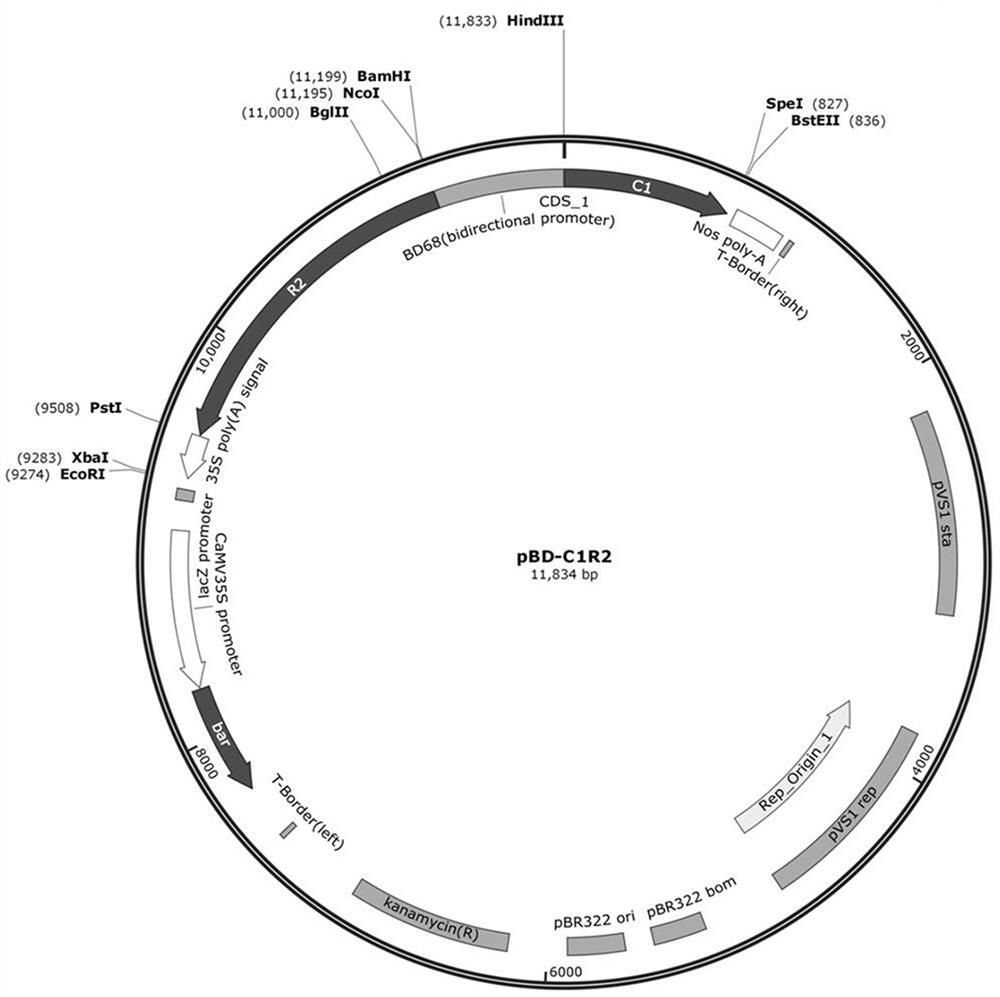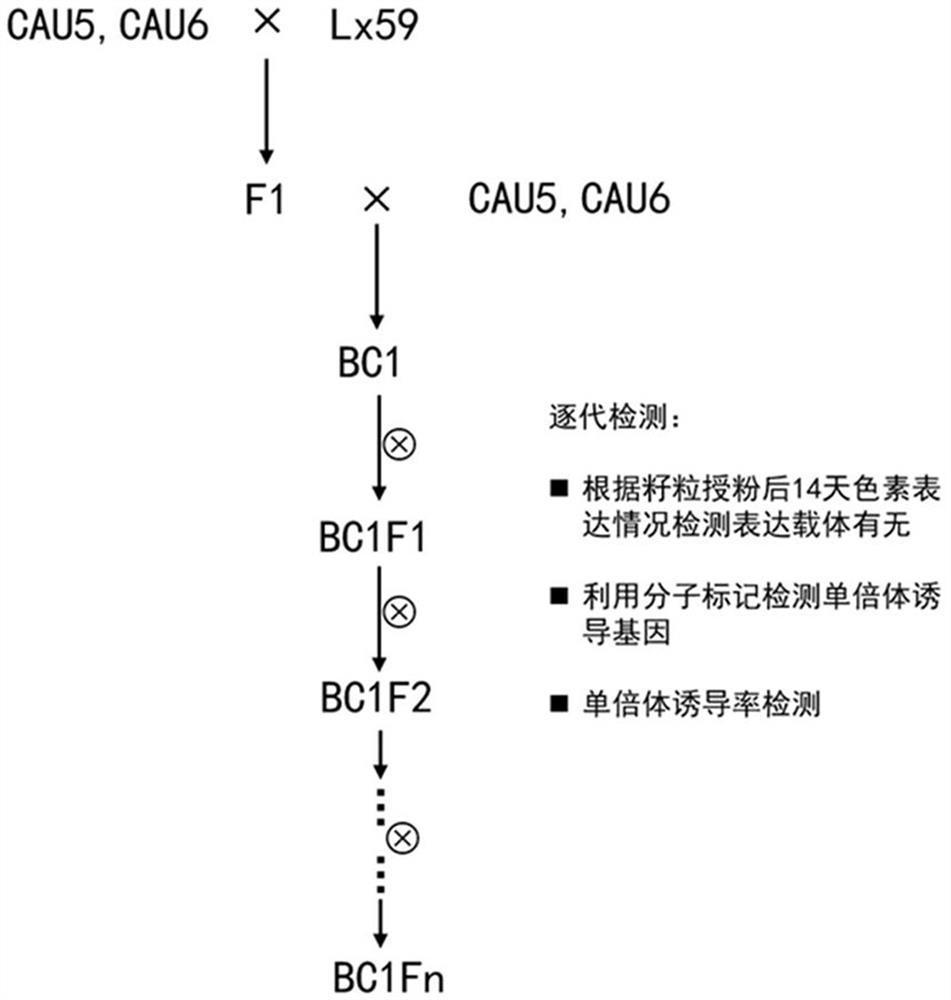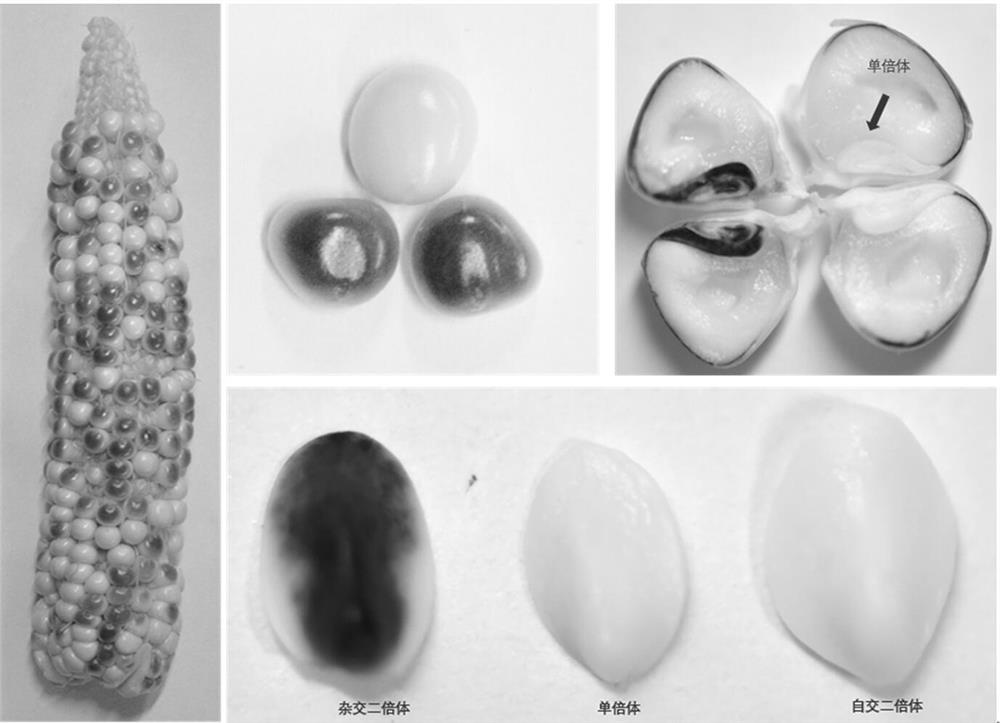A rapid chromogenic parthenogenetic induction line and its application in the identification of maize haploid
A technology of parthenogenesis and haploid, which is applied in the rapid chromogenic parthenogenetic haploid induction line and its application in the identification of maize haploid, so as to improve efficiency, improve accuracy and reduce the consumption of culture materials Effect
- Summary
- Abstract
- Description
- Claims
- Application Information
AI Technical Summary
Problems solved by technology
Method used
Image
Examples
Embodiment 1
[0026] Example 1 Creation of maize parthenogenic haploid induction line
[0027] 1. Preparation of corn materials
[0028] In July 2018, haploid parthenogenetic inducible lines CAU5 and CAU6 were planted at the experimental base of China Agricultural University in Shangzhuang, Beijing, and Lx59 was planted at the transgenic base of the Chinese Academy of Agricultural Sciences, carrying the vector pBD-C1R2. See the vector structure figure 1, F1 was assembled that year, and then a parthenogenetic haploid induction line with haploid induction ability and target expression vector was created. The parthenogenetic haploid induction line was used to hybridize with the female parent material Zhengdan 958, and the haploid identification accuracy and haploid induction rate were counted. After the expression of the anthocyanin color marker, the haploid identification can be carried out. The parthenogenic haploid induction line created by the invention can identify haploids from 12 days...
Embodiment 2
[0034] Example 2 Identification method of maize haploid immature embryos
[0035] 1. The production of haploids
[0036] 1. Hybridization
[0037] (1) Hybrid parent
[0038] Zhengdan 958 was used as the female parent, and the conventional parthenogenetic haploid induction line CAU5 was used as the male parent, and the hybrid offspring 1 was obtained;
[0039] Zhengdan 958 was used as the female parent, and the conventional parthenogenetic haploid induction line CAU6 was used as the male parent, and the hybrid offspring 2 was obtained;
[0040] Zhengdan 958 was used as the female parent, and the rapid chromogenic parthenogenetic haploid induction line was used as the male parent, and crossed to obtain a hybrid offspring 3;
[0041] (2) Specific method of hybridization
[0042] Before the filaments of the female parent are spit out, they are detasseled and the ears are bagged; after the filaments are spit out, the filaments are cut at the same time, and pollination is perfor...
Embodiment 3
[0067] Example 3 For containing ZmC1 suppressor gene ( ZmC1-I ) Haploid induction experiment of selected line materials
[0068] Color suppressor gene testing
[0069] multiple inbred lines ZmC1-I Genetic testing found that K22 and Yu8701 contain ZmC1-I gene, and use the R1- nj The diploid embryos obtained from the labeled conventional parthenogenetic haploid induction line were poorly colored, and the specific detection primers were as follows:
[0070] C1-IF(5'-3'): TACACTCGCCCTCATAGCAG
[0071] C1-IR(5'-3'): CAAACCTGCACCCACACAC
[0072] 1. Identification of haploid immature embryos
[0073] In May 2020, planted at the Experimental Station of China Agricultural University in Beijing ZmC1-I Germplasm K22 and Yu 8701 were planted together with conventional parthenogenetic haploid induction line CAU6 and rapid chromogenic parthenogenetic haploid induction line. And take the embryo 15 days after pollination, the result ( Figure 7 for K22, Figure 8 Yu 8701) found...
PUM
 Login to View More
Login to View More Abstract
Description
Claims
Application Information
 Login to View More
Login to View More - Generate Ideas
- Intellectual Property
- Life Sciences
- Materials
- Tech Scout
- Unparalleled Data Quality
- Higher Quality Content
- 60% Fewer Hallucinations
Browse by: Latest US Patents, China's latest patents, Technical Efficacy Thesaurus, Application Domain, Technology Topic, Popular Technical Reports.
© 2025 PatSnap. All rights reserved.Legal|Privacy policy|Modern Slavery Act Transparency Statement|Sitemap|About US| Contact US: help@patsnap.com



